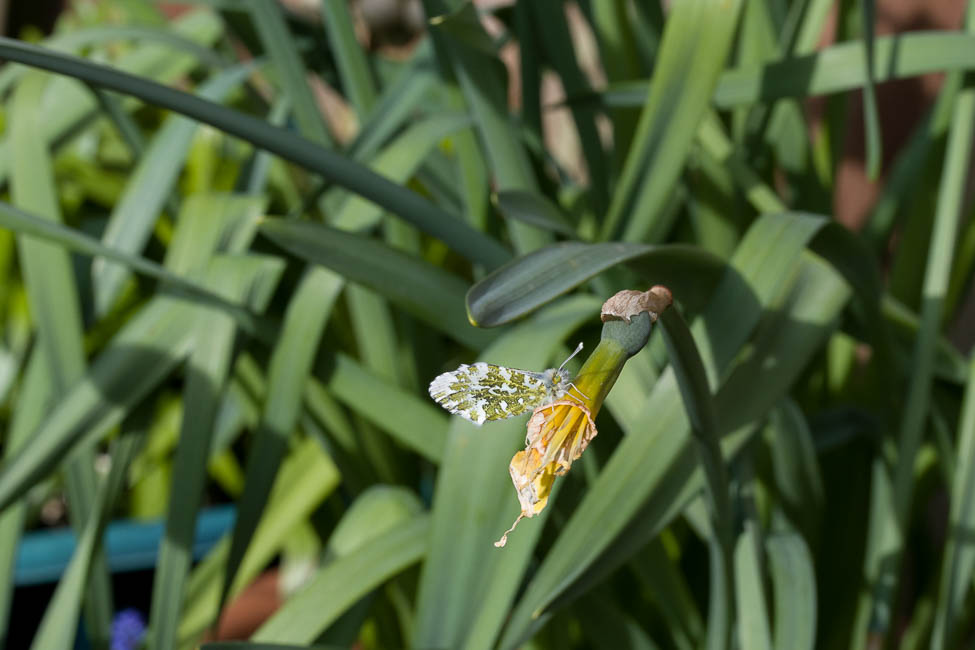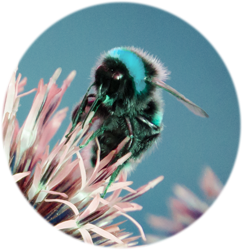We saw a small white butterfly land in our garden. Very early in our year to see any butterfly, especially as the weather is unusually cold. And then the butterfly disappeared from sight. Where did it go?
Our daffodils and narcissi have been great this year. They flowered for a long time and now are looking a bit past it. All the petals are wilting. But look closely!

In the middle of this group, there’s something unusual. Focus in to see what it is.

And it’s that little butterfly clinging on to a wilting daffodil head. And it’s not moving and……Do I have time to get my macro lens to get a closer look?
Yes! It’s still there when I get back.

A female Orange Tip Butterfly – a species that just starts appearing here at the end of April – very common in the UK. While the upper wings give the appearance of a simple white-winged insect, the undersides are covered with this remarkable camouflage, which is common to both sexes. It’s so easy to miss one of these when they are sitting right in front of you. But, the detail that you can pick out in macro is astonishing. Who would have thought butterflies are so hairy?
Now this particular butterfly clung onto that daffodil head for more than 24 hours, and it was still there the next morning. It wasn’t hiding deep in grasses – it was there plain to see except for its camouflage. And there quite a few birds in our garden just now.
The name Orange Tip is more easily understood when you see the male. These close-up photos below were taken a few years ago and they show the wee fella before and after the opening up his wings. You can just see the orange through the wings in the first image.



Amazing what you see and learn when you get up close.
This post is set up in answer to the Patti’s Lens-Artists Photo Challenge -Focusing on the Details. Use the link to see the original challenge and everyone’s responses.


what an amazing-looking creature – the yellowish texture on the outside and the surprise of ‘ORANGE’ on the wing tops!
LikeLiked by 1 person
Yes! It’s amazing that the one side is for show and the other side is for camouflage.
LikeLike
I’ve never seen that level of detail on an orange tip. Wonderful macros
LikeLiked by 1 person
Thank you!
LikeLiked by 1 person
Wow. Great series. Very well done.
LikeLiked by 1 person
Thanks John!
LikeLiked by 1 person
Excellent and interesting – wonderful detail! That butterfly I have seen many times showing the orange side – I am pretty sure I have seen the other side of the wings as well – and thought it was another species! These are spectacular finds to me, thank you!
LikeLiked by 1 person
Thanks Ann-Christine! I’m always amazed by butterflies. Photography continues to be an educational activity.
LikeLike
I am not successful with butterflies – admire all of you who are!
LikeLiked by 1 person
Wow, James. These images are amazing! Fabulous details. Your knowledge of this butterfly is wonderful! Thanks so much for sharing and joining us.
LikeLiked by 1 person
Thanks Patti! Your challenge just came at the right time as I had just taken the photos a few days earlier.
LikeLiked by 1 person
Wonderful.
LikeLiked by 1 person
Lovely to see this butterfly up close.
LikeLiked by 1 person
Pretty amazing James – the images from a bit further away make its wings look almost transparent and then WHOA – look at that burst of orange! Wonderfully surprising detail.
LikeLiked by 1 person
Thanks Tina! The male orange ones are easily spotted in flight but they hardly ever seem to settle anywhere. The females perhaps harder to pick out because in flight they look quite like other species.
LikeLike
Wow… amazing butterfly images! Beautiful details and colors!
LikeLiked by 1 person
Thanks, Amy
LikeLike